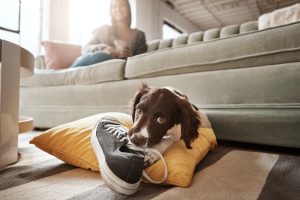September has arrived and so begins the back to school routine. While we may be adjusting to new schedules, it is essential not to forget about how this change in routine will affect another important member of the family – your beloved furry friend.
Dogs, in particular, can be sensitive to changes in their environment and routines. With a little preparation, you can ensure a smooth transition for your four-legged companion when the kids go back to school. Dogs thrive on routine so any sudden shifts in their daily schedule can be unsettling. To help the dog adapt, start gradually adjusting their routine a few weeks before school begins. Begin by shifting meal times, walks, and play sessions to more closely match the upcoming schedule. This gradual change will allow your dog to acclimatise without feeling overwhelmed.
Increase Alone Time Gradually
During the summer, your dog might have been accustomed to having the whole family around. Suddenly being left alone for extended periods when school starts can trigger separation anxiety. To prevent this, gradually increase the amount of time your dog spends alone. Start with short periods and slowly extend the time as your dog becomes more comfortable. This will help build their confidence and reduce the stress associated with being alone.
Stimulate Your Pet at Home
Boredom can lead to destructive behaviors in dogs, so it’s crucial to keep them mentally and physically stimulated, especially when they’re spending more time alone. Here are some ideas to engage your pet at home:
- Interactive Toys: Invest in toys that challenge your dog’s problem-solving skills. Puzzle feeders or treat-dispensing toys are great options to keep them engaged and mentally active.
- Training Sessions: Spend time teaching your dog new tricks or commands. Not only does this keep their mind busy, but it also strengthens the bond between you and your pet.
- Sensory Stimulation: Create sensory experiences for your dog by hiding treats around the house for them to find. This taps into their natural instincts and keeps them engaged.
- Rotate Toys: To prevent monotony, rotate your dog’s toys regularly. This trick makes “old” toys feel new again, sparking their interest and curiosity.
- Nature Walks: Even if your dog is spending more time indoors, make sure to take them on regular walks to explore the outdoors, smell new scents, and engage with the environment.
Recognising and Addressing Separation Anxiety
Even with gradual preparation, some dogs may still experience separation anxiety when the house suddenly becomes quieter. Watch for signs of anxiety, such as excessive barking, destructive behavior, or changes in eating habits. Initially, consider using a calming supplement to assist with the transition. Kalm Aid Tablets are an L-Tryptophan based supplement that helps to calm pets during periods of stress and anxiety. Kalm Aid Tablets are useful for situations such as anxiety due to separation from owner or unwanted unruly behaviour. Kalm Aid Tablets promotes relaxation and reduces nervous irritability which can help in addressing the separation anxiety associated with the change in routine.
Creating a Positive Departure Routine
When the time comes to leave for school or work, create a positive departure routine that reassures your dog. Offer treats or a special toy as you leave, so your dog associates your departure with positive experiences. Avoid making a big fuss when you leave or return, as this can contribute to anxiety. Instead, keep arrivals and departures calm and low-key.
Remember that each dog is unique, so be patient and attentive to their needs. With the right approach, you can ensure that your furry family member remains happy, healthy, and content throughout the changing seasons.



